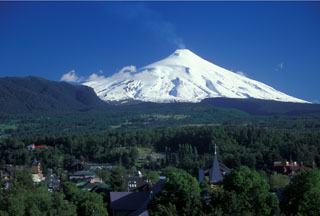Report on Villarrica (Chile) — 23 November-29 November 2022
Smithsonian Institution / US Geological Survey
Weekly Volcanic Activity Report, 23 November-29 November 2022
Managing Editor: Sally Sennert.
Please cite this report as:
Global Volcanism Program, 2022. Report on Villarrica (Chile) (Sennert, S, ed.). Weekly Volcanic Activity Report, 23 November-29 November 2022. Smithsonian Institution and US Geological Survey.
Villarrica
Chile
39.42°S, 71.93°W; summit elev. 2847 m
All times are local (unless otherwise noted)
POVI reported minor gas-and-steam emissions at Villarrica on 24 November; one circular emission (“vortex ring”) was also visible. During an overflight on 25 November, SERNAGEOMIN scientists observed the small cone on the crater floor with an incandescent lava lake at its center. The lake temperature was 1,043 degrees Celsius. The Alert Level remained at Yellow (the second lowest level on a four-color scale) and the public was warned that material could be ejected within 500 m of the crater. ONEMI remained the Alert Level Yellow (the middle level on a three-color scale) for the municipalities of Villarrica, Pucón (16 km N), Curarrehue, and the commune of Panguipulli.
Geological Summary. The glacier-covered Villarrica stratovolcano, in the northern Lakes District of central Chile, is ~15 km south of the city of Pucon. A 2-km-wide caldera that formed about 3,500 years ago is located at the base of the presently active, dominantly basaltic to basaltic-andesite cone at the NW margin of a 6-km-wide Pleistocene caldera. More than 30 scoria cones and fissure vents are present on the flanks. Plinian eruptions and pyroclastic flows that have extended up to 20 km from the volcano were produced during the Holocene. Lava flows up to 18 km long have issued from summit and flank vents. Eruptions documented since 1558 CE have consisted largely of mild-to-moderate explosive activity with occasional lava effusion. Glaciers cover 40 km2 of the volcano, and lahars have damaged towns on its flanks.
Sources: Proyecto Observación Villarrica Internet (POVI), Servicio Nacional de Geología y Minería (SERNAGEOMIN), Oficina Nacional de Emergencia-Ministerio del Interior (ONEMI)

